By Aaron Earls
According to the latest release from Pew Research, fewer Americans identify as Christians today than in 2007. In general, Christianity declined almost 8 percent as a share of the U.S. population.
However, the real collapse came among Mainline Protestants. The share of Americans who affiliate with a Mainline church fell below 15 percent. In addition, the share of American Catholics fell to 20.8 percent.
The overall decline among Christians is significant, particularly when accompanied by an almost 7 percent jump in the religiously unaffiliated.
A surface level skim of the Pew study offers a grim reflection of Christianity in America. But the underlying data gave a more complicated (and perhaps encouraging) picture.
Growth of Evangelicals
Evangelicals are growing and now make up a clear majority of American Protestants—55 percent of Protestants identify with evangelical churches, up from 51 percent in 2007. Those identifying as evangelical also include an increasing number from non-evangelical groups like Mainline Protestants (27 percent), Catholics (22 percent), and Orthodox (18%).
This “evangelicalization” of American Christianity, as Ed Stetzer has called it, will only intensify if the trends for evangelicals and Mainline Protestants continue.
Mainline Protestants declined by more than 3 percent of the population, due in part to their losing almost twice as many people as they brought in. For every new person claiming to be Mainline, 1.7 walk away.
By contrast, evangelicalism was one of the few major faith groups who added more people than it lost. While 8.4 percent of the population said they were raised evangelical, but are no longer, 9.8 percent said they didn’t grow up evangelical, but consider themselves to be now.
The study reveals “a long, slow, but accelerating decline of mostly nominal Christianity,” says Stetzer. He explains that more nominal Christians now self-identify as religiously “unaffiliated.” People who previously marked “Christian” on a religious survey because they weren’t Hindu or Jewish are now choosing “none of the above.” Simply put, the nominals are becoming the nones.
Data from the General Social Survey reveals most of the “nominals becoming nones” are leaving the ranks of Mainline Protestantism, but not evangelicalism.
Within evangelicalism, the ratio of nominal or cultural Christians (those who merely claim the cultural label) to committed Christians (those who allow their faith to regularly influence their life) has remained fairly steady.
Both the numbers of those who identify with an evangelical denomination and evangelicals who say they attend church regularly have increased since 1972. The gap between the two has continued around 10 percent.
This seems to indicate that evangelical Christianity is increasing in committed members, those who attend church more than two or three times a month, as well as picking up more cultural Christians.
Using the GSS data, more than 1-in-5 Americans say they are affiliated with an evangelical denomination, while 1-in-8 Americans say they are a regular church attending evangelical.
Decline of Mainline Protestants
The statistics tell a much different story for Mainline Protestantism. There is decline in both the share who identify with a Mainline church and those who regularly attend, but the drop among identifiers is much more drastic.
Regular Mainline church attenders hovered around 8 percent of the population in the 1970s, but has fallen to between 3 and 4 percent in the last decade.
Meanwhile, those who identified as Mainline Protestants peaked at close to 30 percent four decades ago, only to bottom out at 12 percent in 2012. Only time will tell if that trend continues.
A 20 percentage point gap between those who identify as Mainline and those who attend has shrunk to less than 9 percent.
In addition, Pew found those raised as Mainline Protestants were more likely than any other Christian group to become religiously unaffiliated. More than a quarter (26 percent) of those who grew up Mainline now identify as a “none.”
It’s true that nominals are becoming nones, but it’s more specifically true that most Mainline nominals have already become the nones.
As Stetzer made clear in an article for CNN, Christianity is not dying. There are problematic signs that need to be addressed and the shape of the faith in America is definitely changing, but its death is nowhere near imminent.
AARON EARLS (@WardrobeDoor) is online editor of FactsAndTrends.net.









